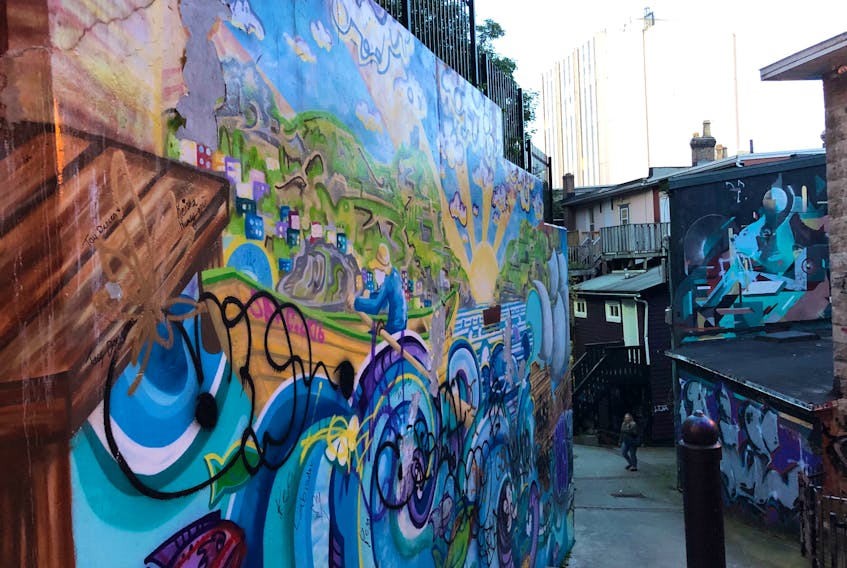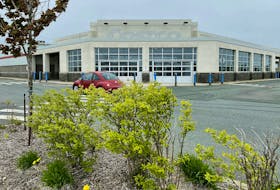ST. JOHN'S, N.L. — A concrete grey overpass is framed in the shot by green grass and trees. There’s a light breeze.
It’s daylight.
A few dandelions are visible, though their vibrant yellow has now turned to the puff of white-grey seedhead, matching the concrete.
From the left appears a man, dressed in black and wearing a black ball cap. He has a backpack, and a black dog trots beside him. His back is to the camera, as he bends to pull something from his backpack.
A crow caws.
Quickly now, another sound, like a swoosh swoosh, and then a rattle, as the man deftly scrawls his tag - a stylistic signature - in black spray paint on the concrete.
He slings his backpack and walks away.
The one-minute video was posted to Instagram this summer by a graffiti artist in St. John’s.
Graffiti can be seen in many parts of the city - from tags on concrete along the new stretch of Team Gushue Highway, to more elaborate pieces on the graffiti walls in downtown alleys.
‘It’s disgusting to me’
However elaborate, St. John’s city council is not impressed.

Just last month, the city created a task force on graffiti with Coun. Deanne Stapleton at the helm.
She’s in the early stages of organizing a group of people to make up the task force. Stapleton said she’ll seek representatives from the city, Clean St. John’s, Royal Newfoundland Constabulary (RNC), the downtown business community, and perhaps a local artist.
“We’ve got visitors from everywhere coming into our city. Do they really want to see graffiti on part of an old building that’s probably three or four hundred years old? You know, it’s disgusting to me,” said Stapleton.
She said her goal is to encourage more people to report graffiti.
“That way it’s recognized quicker, it’s removed more quickly, and it’s not around our city.”
Stapleton said people should report graffiti on city property by dialing 311, and on any other property by calling the RNC at 729-8000, or report anonymously through Crime Stoppers.
Under the Criminal Code of Canada, the creation of graffiti is considered vandalism. Vandals can be charged with mischief under or over $5,000.
Graffiti vandalism is also a bylaw infraction in cities across Canada.
In St. John’s, property owners are responsible for removing graffiti and incur any costs associated with the removal. If the city is notified of graffiti on businesses, staff will contact property owners and give them a period of time to clean it up. If it’s not done by a property owner, the city will do it and send the bill.
Stapleton said the city makes an effort to remove any graffiti on city property within 24 hours of being notified.
She said the city spent $10,000 in 2018 removing graffiti from city-owned property. That’s down significantly from a few years ago when the vandalism seemed to peak, and the city spent three times as much.
According to The Telegram’s archives, in 2009, the city spent $35,000 cleaning up graffiti. In 2011, that number decreased to $19,420, but by 2013 was back up to $34,695.
A Graffiti Management Plan was put in place through a joint effort of the city and Royal Newfoundland Constabulary (RNC) in 2008, but Stapleton said she believes it was never implemented.
RNC spokesperson Cst. James Cadigan told The Telegram the police force has had focused efforts in recent years that led to identifying some of the people responsible.
Vandalism or art?
"Art's rightful place is on the cave walls of our communities where it can act as a public service, provoke debate, voice concerns, forge identities.” -Banksy
Arguably the most famous graffiti artist in the world is Banksy.
He’s widely considered an artist, even though what he does is illegal.
A framed copy of his Balloon Girl work sold at an art auction for £1.04m last year, yet his reputation as an artist didn’t stop Westminster City Council in London from ordering the removal of one of his murals painted in 2008. The council said it would remove any graffiti, regardless of who created it.
Robert Davis, the chairman of the council planning committee told The Times newspaper in Australia: "If we condone this then we might as well say that any kid with a spray can is producing art."
But even among some art educators, there’s a difference between throwing up a quick tag and spending time on an elaborate mural.
Professor Lorrie Blair is acting chair of art education at Concordia University in Montreal where she teaches student art teachers about ways to use graffiti to motivate students.

“If I wanted to teach drawing, I could go to somebody like Banksy, and Banksy says, look, you need to know how to draw. So, we’re trying to use it to motivate students.”
Still, she said only educators who are well-established and knowledgeable about their communities should try incorporating graffiti into an art classroom because it is an illegal activity and the aim is not to condone it.
Yet Blair said some of the most interesting art that is happening lately is in graffiti.
“They’re tourist attractions. I think the fact that they’re illegal kind of makes them better,” she said, explaining the difference in graffiti and city-sanctioned murals.
“I keep going to Banksy because his work is so political, it’s so thought-provoking, and it shows up in places that you don’t expect. Where I think that once a city gets involved, it’s a city council, you’re going to decide what building, what is allowed.”
Still, Blair said she believes there’s a difference between vandalism and art.
Ian Gidge, who runs the social media account NL Street Art, said the difference between the two is perspective.
“It’s definitely seen as vandalism to some, and art to others,” he said.
Gidge started documenting street art in St. John’s in 2015 as a side project because he wanted to showcase the city-commissioned traffic box art to a wider audience online.
As he walked around the city taking pictures of the traffic boxes, he noticed graffiti in alleyways and on buildings, so he began posting photos of graffiti, too.
“A boring brick wall could be turned into a great work of art when done correctly. Just look at the giant mural outside the new Mary Brown’s downtown,” he said.
That mural was commissioned by the company.
“I think there are some great graffiti artists in the city, and I’m a fan of their work,” he said, but he added: “I generally avoid posting photos of blatant tagging and personal property that has been graffitied.”
City grappled with graffiti 100 years ago
About that boring brick wall.
Coun. Stapleton suggested commissioning more murals in the city as a way to perhaps curtail the illegal activity.
“There’s so many empty spaces out there for them to do graffiti,” she said.
Stapleton said what distinguishes graffiti from art, in her view, is permission.
“You can get a permit or something, so that if you want to do community art, or if you’ve got a fence on your property that is on a major street, you can get permission to do artwork. So, that’s not considered then graffiti, it’s considered art.”

However, according to an article in the Royal Canadian Mounted Police’s Gazette magazine from 2015, while legal walls appear to work at first, after time the surrounding areas also become covered with graffiti.
Blair said her students have told her it’s about “claiming a space”.
“It’s saying, how come McDonald’s can put their ‘tag’ everywhere, but I can’t? Why are corporations allowed to tag a city with their tags, with the billboards? And I can’t?
“And kids don’t have space, that’s one of their issues. So, they have to steal space because places don’t give them parks that are just for them where they can just go and tag it if they want.
“In cities, you have to buy something to go to a bathroom. And so, there’s no place for teenagers to be. So, I see their point on that side.”
It’s an issue dating back at least a century in St. John’s.
An article in the St. John’s Daily Star on June 23, 1917, details ongoing vandalism of a bathing-house at Long Pond.
“…the interior of the house was in a disgraceful condition, the boarding being covered with writing, etc., and the names of many boys scribbled thereon,” it reads.
The writer goes on to say it’s “high time that a stop should be put to such wanton acts of vandalism.”
Graffiti itself has existed around the world since ancient times, carved into walls and monuments.
Only time will tell how effective St. John’s city council’s task force will be in addressing it locally.
Meantime, the current solution is akin to the dandelion in the Instagram video.
Just as the weed changes from vibrant yellow to grey-white, property owners around the city scramble to remove or cover graffiti writers’ colourful work with white paint.
But then, as sure as the weed returns every Spring – dotting manicured lawns with pops of yellow – so does graffiti.
Twitter: @juanitamercer_









